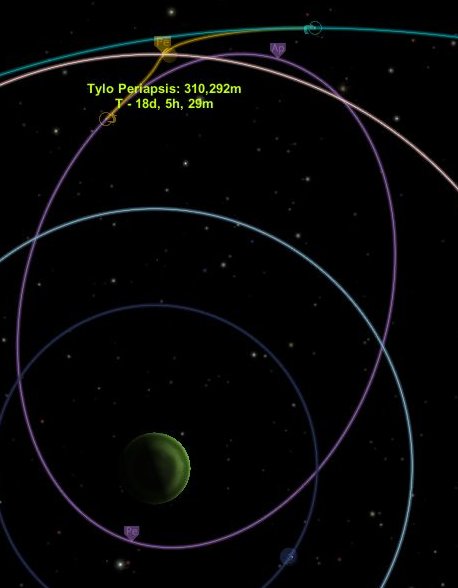Difference between revisions of "Tutorial: Gravity Assist/zh-cn"
m |
|||
| Line 7: | Line 7: | ||
*'''对应版本:'''0.18.4 | *'''对应版本:'''0.18.4 | ||
| − | == | + | == 如何进行 == |
| − | + | 在这个例子里,我们要离开Kerbin,利用Mün完成引力助推,并进入前往Duna的轨道。通常,你需要把轨道远点高度提升到八千五百万公里才能脱离Kerbin。用这个办法,我们只需要进入Mün轨道(一千两百万公里)就可以。这样可以为你节约相当于几百m/s delta-v的燃料。 | |
| − | # | + | # 飞船进入环Kerbin低圆周轨道; |
| − | # | + | # 缩小图像直到可以看到Kerbin的公转轨道; |
| − | # | + | # 按照"Going to the Mün"教程中学到的方法,安排前往Mün的飞掠轨道,需要注意的一点是,应该注意到达Mün时,它正向你需要的方向前进。在本例中,我们需要的是飞离太阳的方向,因此在设计轨道时注意Mün的运行方向 —— 即Mün轨道与Kerbin公转轨道交汇的时刻; |
| − | # | + | # 加速时间,直到抵达Mün的引力范围; |
| − | # | + | # 现在规划一次轨道校正机动。因为引力助推离目标天体距离越近效果越明显,所以只要不发生碰撞,离Mün越近越好。你的Mün轨道近点应位于Mün运行方向的后方。如果飞船从前方经过Mün,你会减速而不是加速。同时应注意轨道的倾角 —— 太高就会有问题了; |
| − | # | + | # 加速时间,直到离开Mün的引力范围; |
| − | # | + | # 观察轨道地图,你会发现飞船现在的轨道比飞掠Mün前变得更长(轨道远点很可能位于Minmus轨道的后方),但它并不是Kerbin的逃逸轨道。你还没有从Mün获得足够的全部速度; |
| − | # | + | # 所以,再进行一次轨道校正机动,再度飞掠Mün,并尽可能靠近它飞行; |
| − | + | 祝贺你,你现在会进入一条大致飞向Duna的轨道,而又为返程省下了足够的燃料。如果希望返回Kerbin,你可以利用Ike进行类似的机动。 | |
== Reverse Gravity assist == | == Reverse Gravity assist == | ||
Revision as of 04:38, 24 June 2013
重力助推是一种非常节约燃料的加速(或减速)机动方式。这种机动就是,当位于天体的引力范围球体之内时,它会对飞船产生一定的牵引力,从而相应为飞船产生加速(或减速)的效果。当你飞离某颗行星,如果它带有卫星,那么我们就可以利用该卫星进行重力加速机动,从而节约大量的燃料。
- 长度:30分钟
- 难度:适中
- 对应版本:0.18.4
如何进行
在这个例子里,我们要离开Kerbin,利用Mün完成引力助推,并进入前往Duna的轨道。通常,你需要把轨道远点高度提升到八千五百万公里才能脱离Kerbin。用这个办法,我们只需要进入Mün轨道(一千两百万公里)就可以。这样可以为你节约相当于几百m/s delta-v的燃料。
- 飞船进入环Kerbin低圆周轨道;
- 缩小图像直到可以看到Kerbin的公转轨道;
- 按照"Going to the Mün"教程中学到的方法,安排前往Mün的飞掠轨道,需要注意的一点是,应该注意到达Mün时,它正向你需要的方向前进。在本例中,我们需要的是飞离太阳的方向,因此在设计轨道时注意Mün的运行方向 —— 即Mün轨道与Kerbin公转轨道交汇的时刻;
- 加速时间,直到抵达Mün的引力范围;
- 现在规划一次轨道校正机动。因为引力助推离目标天体距离越近效果越明显,所以只要不发生碰撞,离Mün越近越好。你的Mün轨道近点应位于Mün运行方向的后方。如果飞船从前方经过Mün,你会减速而不是加速。同时应注意轨道的倾角 —— 太高就会有问题了;
- 加速时间,直到离开Mün的引力范围;
- 观察轨道地图,你会发现飞船现在的轨道比飞掠Mün前变得更长(轨道远点很可能位于Minmus轨道的后方),但它并不是Kerbin的逃逸轨道。你还没有从Mün获得足够的全部速度;
- 所以,再进行一次轨道校正机动,再度飞掠Mün,并尽可能靠近它飞行;
祝贺你,你现在会进入一条大致飞向Duna的轨道,而又为返程省下了足够的燃料。如果希望返回Kerbin,你可以利用Ike进行类似的机动。
Reverse Gravity assist
Should you enter the Duna-Ike system in a suitable trajectory, you can perform a reverse-gravity-assist to lose speed instead of gaining it. To do so just do an Ike-fly-by. In order to lose speed instead of gaining it, your Ike periapsis needs to be in front of Ike's trajectory instead of behind it.
Powered Gravity assist
To get even more out of a gravity assist, you can perform a powered gravity assist. As you know, accelerating at your periapsis has the greatest effect on your apoapsis. This still applies to your periapsis during a gravity assist. When you accelerate during your fly-by, this fuel is used very efficiently to increase the apoapsis of your final trajectory. This is, however, a very difficult technique, because it is hard to control your final trajectory, even when using a maneuver node.


